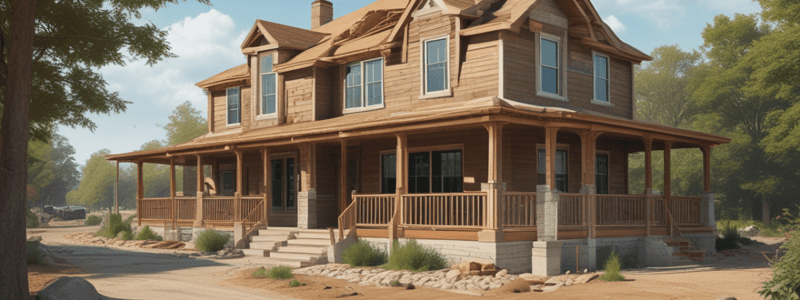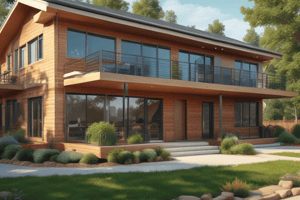Podcast
Questions and Answers
What is the purpose of removing interior doors before hanging the trim?
What is the purpose of removing interior doors before hanging the trim?
- To simplify the installation of the door frames (correct)
- To prevent damage to the doors during installation
- To make the painting process easier (correct)
- To enable better access to the walls for painting
What type of caulk is primarily used for filling gaps before painting?
What type of caulk is primarily used for filling gaps before painting?
- Polyurethane caulk
- Latex caulk (correct)
- Silicone caulk
- Acrylic caulk
At what stage of construction are baseboards and shelving typically installed?
At what stage of construction are baseboards and shelving typically installed?
- During the finish work stage (correct)
- Before the exterior finishes
- During the framing process
- After the roofing is completed
Why is it beneficial to caulk before painting?
Why is it beneficial to caulk before painting?
Which of the following items is typically installed after the home has been painted?
Which of the following items is typically installed after the home has been painted?
What should be done to windows during the painting process?
What should be done to windows during the painting process?
What is commonly installed in the mudroom and other spaces during the finish work?
What is commonly installed in the mudroom and other spaces during the finish work?
What is the primary reason for using a spray gun during the painting phase?
What is the primary reason for using a spray gun during the painting phase?
What is required before a builder can start the construction of a home?
What is required before a builder can start the construction of a home?
Who is primarily responsible for preparing the land for construction?
Who is primarily responsible for preparing the land for construction?
What initial action is taken during the land preparation process?
What initial action is taken during the land preparation process?
What infrastructure improvements does the land developer perform?
What infrastructure improvements does the land developer perform?
Which of the following is NOT a responsibility of the land developer?
Which of the following is NOT a responsibility of the land developer?
What might a builder need to ensure a smoother home building process?
What might a builder need to ensure a smoother home building process?
After the land is prepared, which feature is installed to manage excess water?
After the land is prepared, which feature is installed to manage excess water?
What type of map is used to show the layout of roads and home sites in a community?
What type of map is used to show the layout of roads and home sites in a community?
What is the purpose of stubbing in home construction?
What is the purpose of stubbing in home construction?
What is the main function of the concrete footings in home construction?
What is the main function of the concrete footings in home construction?
What is the purpose of the rebar in the foundation walls?
What is the purpose of the rebar in the foundation walls?
Which step comes after pouring the concrete footings in the home building process?
Which step comes after pouring the concrete footings in the home building process?
Why are window wells bolted around basement windows?
Why are window wells bolted around basement windows?
What distinguishes the sill plate from other framing materials in home construction?
What distinguishes the sill plate from other framing materials in home construction?
What is the minimum curing time for concrete before framing can start?
What is the minimum curing time for concrete before framing can start?
Which component is crucial for allowing the house to sway during major storms?
Which component is crucial for allowing the house to sway during major storms?
What is the primary role of the pump truck during the concrete pouring process?
What is the primary role of the pump truck during the concrete pouring process?
What does the term 'flat work' refer to in the home construction process?
What does the term 'flat work' refer to in the home construction process?
Flashcards are hidden until you start studying
Study Notes
Home Construction Process Overview
- Comprehensive guide focusing on the new home construction process.
- Aims to provide an accurate and in-depth look at how homes are built.
- Includes tips for a smoother building experience and higher quality homes.
Preparation Before Construction
- Builders require an approved plot map from the city before construction begins.
- The plot map illustrates the layout of roads, parks, green spaces, and home sites.
- Land developers submit the plat to the city and subsequently sell home sites to builders.
Land Preparation
- Once approved, developers prepare the land by leveling and clearing debris, which may include trees and old structures.
- Multiple vehicles often operate simultaneously to perform various preparation tasks.
- After land prep, developers install essential infrastructure such as curbs, gutters, and asphalt roads.
Water Management and Safety Infrastructure
- Developers are responsible for implementing drainage systems for excess water management in the community.
- Fire hydrants are also installed as part of safety measures during the land preparation phase.### Home Building Process Overview
- Each property corner is marked with sticks or orange caps indicating boundaries for multiple home sites.
- Utilities, including sewer, natural gas, electrical, and water lines, are installed during land development; this process is known as "stubbing."
- An inspection process occurs before construction begins, ensuring compliance with local codes.
Construction Steps
- Site Marking: Builders mark the home site using plot plans, placing pegs and spray paint to guide excavators.
- Excavation: A backhoe digs the hole, wider than the house footprint for operational space; virgin soil provides stability.
- Foundation Preparation:
- Concrete footings are poured to bear the house weight and prevent settling.
- Rebar is incorporated into the footings for added strength.
- Foundation Walls: Forms set around footings hold rebar; concrete is pumped in continuously for strong bonding.
Foundation Details
- Key Feature: A "key" juts out from the foundation wall, supporting future steps and preventing sinking.
- Earthquake/Hurricane Straps: Installed for structural integrity during severe weather, ensuring flexibility without breakage.
- Utilities Installation: Main water and sewer lines are run to future fixture locations; damp proofing is applied to foundation walls to prevent moisture infiltration.
Backfill and Compaction
- After foundation work, the area is backfilled with soil, compacted to prevent long-term settling. Special machines condense the surrounding soil.
Concrete Work
- Garage and basement floors are poured, known as flatwork; driveways are poured later to avoid damage.
- The placement of power, gas lines, and electrical posts ensures early access for tradesmen during construction.
Framing Process
- Sill Plate Installation: The foundation is connected to the home framing with a pressure-treated sill plate to resist rot and pests.
- Floor Joists: Joists span the foundation and are spaced for structural stability, often supported by interior walls.
- Wall Panels: Exterior framing uses 2x4 or 2x6 studs; wall panels are constructed in sections with openings for windows and doors.
Roofing and Insulation
- Roof Installation: Asphalt underlayment is applied before shingles; flashing protects vulnerable areas from water intrusion.
- Four-Way Inspection: A city inspector verifies framing, electrical, HVAC, and plumbing systems before insulation goes in.
Sheetrock and Finishing
- Sheetrock Delivery: Drywall sections are specific to the house dimensions, secured with screws, and covered with joint compound for a smooth finish.
- Mud and Tape Process: Covers seams and reinforces joints; textures can vary based on finishes chosen (round or square corners).
Exterior Work
- Driveway and Siding: Concrete driveways are poured; the home is wrapped with a weather barrier before installing siding or stucco.
- Stucco Process: Involves multiple layers with specific curing requirements to ensure durability and moisture control.
Additional Construction Insights
-
All building stages are interconnected; delays in one area can impact subsequent tasks.
-
Inspections are crucial at each stage to ensure safety, compliance, and quality craftsmanship.### Home Construction Process
-
Houses in winter may be tinted to optimize heating efficiency while heaters maintain indoor temperatures.
-
Step 30: Installation of brick or stone commonly occurs before applying stucco and often at a later stage in the building process.
Interior Finish Work
- Step 31: Finish work involves the installation of baseboards, door casing, shelving, and similar elements.
- Interior doors need to be removed during the trim installation to avoid obstruction, allowing for easier painting.
- Baseboards are added along the floor, and casing is fitted around doorways, enhancing aesthetic appeal.
- Windowsills may be included in the build for durability, contrasting with drywall.
- Staircase railings and handrails are typically installed post-painting for practicality.
Additional Features and Installations
- Wooden fireplace mantels, mudroom benches, and wood shelving are integrated into spaces like laundry rooms and kitchens.
- Metal or wire shelving installation occurs after painting is completed to ensure cleanliness.
Painting and Finishing Touches
- Step 32: After trim and shelving installation, caulking is performed using latex caulk for a neat finish and gap filling.
- Caulk smooths out cracks and provides a polished look on windowsills and other trim areas.
- Following caulking, windows are covered with plastic, and areas not to be painted are taped off for protection.
- Doors are leaned against walls or stored in less obstructive areas until they can be painted.
- Interior painting creates fumes; occupants should avoid the space during this phase for safety.
- The painting process typically begins with a primer, followed by additional coats applied on subsequent days.
Studying That Suits You
Use AI to generate personalized quizzes and flashcards to suit your learning preferences.




